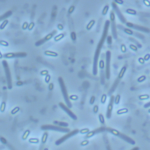Link to Pubmed [PMID] – 40111048
Link to DOI – 10.1128/mbio.03753-24
mBio 2025 Mar; (): e0375324
Clostridioides difficile, a strict anaerobe, is the major cause of antibiotic-associated diarrhea. This enteropathogen must adapt to oxidative stress mediated by reactive oxygen species (ROS), notably those released by the neutrophils and macrophages recruited to the site of infection or those endogenously produced upon high oxygen (O2) exposure. C. difficile uses a superoxide reductase, Sor, and several peroxidases to detoxify ROS. We showed that Sor has a superoxide reductase activity in vitro and protects the bacterium from exposure to menadione, a superoxide donor. After confirming the peroxidase activity of the rubrerythrin, Rbr, we showed that this enzyme together with the peroxiredoxin, Bcp, plays a central role in the detoxification of H2O2 and promotes the survival of C. difficile in the presence of not only H2O2 but also air or 4% O2. Under high O2 concentrations encountered in the gastrointestinal tract, the bacterium generated endogenous H2O2. The two O2 reductases, RevRbr2 and FdpF, have also a peroxidase activity and participate in H2O2 resistance. The CD0828 gene, which also contributes to H2O2 protection, forms an operon with rbr, sor, and perR encoding a H2O2-sensing repressor. The expression of the genes encoding the ROS reductases and the CD0828 protein was induced upon exposure to either H2O2 or air. We showed that the induction of the rbr operon is mediated not only by PerR but also by OseR, a recently identified O2-responsive regulator of C. difficile, and indirectly by σB, the sigma factor of the stress response, whereas the expression of bcp is only controlled by σB.ROS plays a fundamental role in intestinal homeostasis, limiting the proliferation of pathogenic bacteria. Clostridioides difficile is an important enteropathogen that induces an intense immune response, characterized by the massive recruitment of immune cells responsible for secreting ROS, mainly H2O2 and superoxide. We showed in this work that ROS exposure leads to the production of an armada of enzymes involved in ROS detoxification. This includes a superoxide reductase and four peroxidases, Rbr, Bcp, revRbr2, and FdpF. These enzymes likely contribute to the survival of vegetative cells of C. difficile in the colon during the host immune response. Distinct regulations are also observed for the genes encoding the ROS detoxification enzymes allowing a fine tuning of the adaptive response to ROS exposure. Understanding the mechanisms of ROS protection during infection could shed light on how C. difficile survives under conditions of an exacerbated inflammatory response.





